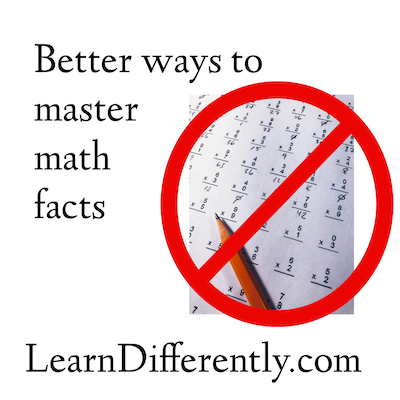Mastering Math Facts

Teaching Math Facts to a Struggling Learner
Try to work on facts every day for 5 to 10 minutes. Some days, let the child pick which method to drill with.
Here are a few suggestions:

- Flash cards, (If you make your own, write answers on the backs, but make sure the answer can’t be read through the cards),
- Better yet, triangle-shaped flash cards. To make them, take cardstock squares, and cut on the diagonal. For addition facts, put the addends in the narrow corners and the sum in the right angle. For multiplication facts, put the factors in the narrow corners, and the product in the right angle. (Make sure you teach and use those words: “addend,” “sum,” “factor,” and “product.”) When you use them, just cover the answer with your thumb.
These cards can be used to teach the inverse operation, that is, addition cards can also be used to drill subtraction facts, and multiplication cards can be used to teach division facts. For example, with one card with 3 and 5 in the narrow corners, and 15 in the right angle, you can teach 4 related math facts: 3 x 5 = 15, 5 x 3 = 15, 15/3 = 5 and 15/5=3. (We call this a “fact family.”) Beginning students can be shown the whole card and asked, “Can you give me a math sentence using these numbers?” If they say, “5 x 3 = 15,” or any of the others, you say, “Good. Can you tell me another… Good, tell me a division sentence using these numbers.” Using triangle cards makes it easier to show and reinforce fact families. - Wrap-ups are one of our favorites. They are a set of plastic strips, about 1 1/2 by 6 inches, with a string tied to one end. Problems on the left, scrambled answers on the right, notches by each. Wrap the string to make lines from problem to answer, then turn it over. If you are correct, the string will line up with the grooves on the back of the strip. So it’s self-correcting and tactile. I used to hand my child four to do whenever we got into the car. Available for all the operations and also for States & Capitals, and other facts, from Timberdoodle.com
- Learning Palettes are made by the same company, but don’t require so much dexterity.
- Drill with The Mad Minute, Calculadders, 2 + 2 is not 5, or another workbook. Frank Schaeffer workbooks are cheap and available at teacher supply stores. Try enlarging these drills with a photocopier, because some children find larger print easier, even if their vision is perfect. These workbooks can be used untimed, to reduce stress.
- A simple board game you can make. Get or make a ‘hundred’ sheet (grid of 10 X 10 squares, each about a square inch, numbered 1 to 100), two pieces from Clue or any board game to be the players (or you can use coins, beans or buttons, as long as they are not identical), and two 10-sided dice from any specialty game store. Get different colored dice. When it’s your turn, roll the dice, announce the numbers, add them aloud, move that many places forward. First person to get to the end wins. You can vary this to cover different operations, e.g., subtract smaller from larger number.
- Teach adding of positive and negative numbers by playing the same game, but let one of the die represent negative numbers. I recommend you use a red die for negative numbers, because negative numbers on your checkbook mean you are “in the red.” Or you could use a black die for positive, since “in the black” is the opposite of “in the red.”
- Bounce on a mini-trampoline as you practice addition facts: Make a poster with lists of digits on it, in random order, maybe 40-50 numbers in all, in 3 or 4 columns. Then each day tell the child what to add to the numbers on the chart. For instance, one day you might say, “Add two to each number” or “Subtract one from each number.” If you had said, “Add two,” the child would read the first number, let’s say it’s a 5, and as she bounces, she says “five (bounce) plus two (bounce) is (bounce) seven (bounce). Then she reads the second number, etc.
- For multiplication, do plenty of skip counting, (counting by threes, fours, etc.), which helped get the answers to the multiplication facts into my child’s head. It was also fun because I let him walk around the house taking one step for each number. Sometimes I told him to steps as large as possible, or to step backwards.
- Demme Learning offers free math resources including math fact songs to familiar tunes (with audio, printed lyrics and music), activities, and webinars.
When You’re Not Drilling
— There’s More to Math Than Times Tables
Daily drilling is important.
But for a learning disabled child, you need not spend 5 years working only on arithmetic facts. Your child can work more sophisticated problems. Some PhDs in math and sciences have more trouble with subtraction than with calculus or writing proofs.
So:
Buy or make a laminated grid or table of the facts your child is struggling to learn. When he is not drilling, but doing other math homework, sometimes letting the child look up the numbers can help him learn those facts. It’s also less stressful than agonizing over one fact for two minutes.
Or let a student who has had long standing trouble learning math facts use a calculator to help only with simple arithmetic.
For example, here is one way to use a calculator when learning long division.
Suppose the problem is 744 divided by 8.
The child knows that 8 does not go into 7, but it goes into 74.
How many times?
Suppose the child guesses 8 times. She writes an 8 in the quotient, over the first 4.
She may use calculator to see that 8 x 8 = 64 and to subtract 74 -64 = 10.
The answer should be smaller than 8, so the child sees that answer is too big.
So the child erases the 8 in the quotient and tries 9.
The child uses the calculator if she is not sure about 8 x 9, and she may use the calculator to find 74 – 72 = 2.
The child knows to bring down the 4, getting 24.
The child then estimates how many times 8 goes into 24, and uses the calculator to check her guess.
Similarly, a child solving 11x + 150 = 7, may use a calculator this way:
Writes 11x + 150 – 150 = 7 -150. Uses a calculator to subtract 150 from 7, gets -143.
Writes 11x = -143.
Uses calculator to divide both sides by 11.
writes x = -13.
© 2006 Katherine Kuhl


These are great ideas!